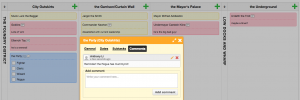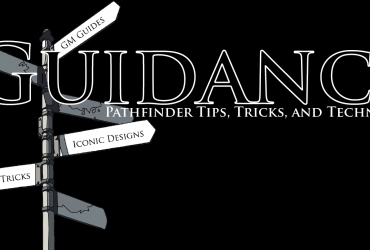Hey all. I figure it’s about time for another installment of Prep With Me. I mean, what good is an ongoing series if it isn’t – you know – on going. Today I want to take a step back from Hell’s Rebels prep an talk about prepping for adventures in general. Specifically I want to touch upon the tools and methods I use to prepare longer campaigns and Adventure Paths.
Before getting too deep into things I want share a bit of wisdom from Helmuth von Moltke (the Elder), a Prussian Field Marshall and strategic analyst circa 1860. One of his more famous lines can be paraphrases as, “No plan survives contact with the enemy”. In the context of a roleplaying game, the assumption being laid out is that no matter how much you plan, or how detailed your notes, your players will end up surprising you. So while plans and pre-campaign preparations can be a useful exercise in helping you focus on the important elements of a story, don’t expect your pre-plans to carry through all the way to the end of the first adventure, let alone the campaign. Always be willing to adapt, adjust, and accommodate the needs and wants of your players.
Okay with that out of the way let’s jump into this.
The Kanban (pronounced Kahn Bahn) Method is a system for developed for agile management of knowledge work with an emphasis on timely delivery of product while keeping production teams focused and not overloaded. Without the business jargon, Kanban is a way for efficient process management. A Kanban board is an organizational tool which allows for management of a product through multiple stages of a process. It’s a powerful organization tool which I’ve recently repurposed into managing my geek.
The type of Kanban board that I use is put out by KanbanFlow. It’s free and browser-based. All you need is an account with email address to access. I like to use Kanban boards to help my plot out “encounter regions”. Basically any subset of an adventure where scripted or random encounters can take place. It also helps me keep track of areas where NPCs might be found prior to the PCs encountering them. This is particularly helpful for urban adventures like Hell’s Rebels or Council of Thieves where there’s a vast city to explore and I need help keeping all the various pieces of it organized.
(click the image to enlarge – I couldn’t get it to resolve any more clearly as it was)
There are a lot of little features built into KanbanFlow that help me keep track of things. I can color code the various elements. I’ve used blue for PCs, yellow for non-hostile NPCs, and red for hostile NPCs. The elements can be moved around the board with a simple click-and-drag and I can even add little notes to remind me of things I need to address later.
If your life is anything like mine you’re super busy. And you’re getting busier all the time. The same can be said of your players. Everyone’s busy! The thing I hate the most about GMing is player wrangling. Chasing down and hounding players to figure out when they’re available so you can figure out when everyone can meet and finally roll dice. I hate it. Thankfully, WhenIsGood has an answer. WhenIsGood is another free browser-based software that helps gaming groups figure out the next best date for a game.
How it works is pretty simple. You don’t even need to register any information, nor do your players need to, removing a critical obstacle in getting responses. Simply select the dates and times you want to offer as potential game days and the contact emails of your players and you’re done! Don’t forget to save the link that they send you so you can check the results of your survey. WhenIsGood then collects the responses they get and map out the dates in which everyone is available. No more wrangling or collating all that information yourself! WhenIsGood even gives you a list of people who haven’t responded so you can bother them about it at your leisure!
So I’m pretty sure this last one isn’t a secret. But I’ve become a big fan of cloud storage and filesharing over the past few years, especially when it comes to organizing my RPGs. For the uninitiated, GoogleDocs is a service/tool that allows anyone with a Google Account view, edit, and share text documents, spreadsheets, presentations, or images. If any changes are made and saved then those changes are instantly reflected for all those with whom the document is shared. There’s even backup functionality if a file gets corrupted or deleted mistakenly. I usually have my players keep a single journal (in- or out-of-charcter, it’s up to them) using GoogleDocs. Not only does it serve as a fun record that we can all look back on once the campaign is over, but it also works as a great way to refresh the memories of my players between sessions. It also gives me a pretty good idea of what my players are absorbing plot-wise and tells me which plot points I should hammer them with again.
So that’s it for this week. Those are the three major tools that I use for organization pre-campaigns. Like I said at the beginning, my drive to make use of these things drastically drops once the game gets underway. But they do help me focus my efforts on what’s important in the beginning. And they certainly help remind me what everyone’s supposed to be doing once we’re deep along on a side quest of a side quest of a tangent of a red herring.
Fancy any other organization tools? Other ways to keep both you and your players focused? Let us know in the comments section below or start a topic on our NEW FORUMS






